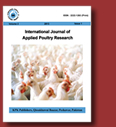|
|
|
|
|
|
|
|
Evaluation of digestibility and feed intake of a date palm by-products
diets fed to Awassi rams
|
|
Muzzamil Atta1*, Osman Mahgoub3, Farhoud H.
Al-Hajri1, Saleh J. Al-Marri1, Isam T. Kadim4,
Mutasim bashir Mohammed laban1,
Nermin Nageh Bashar1,
Khalid Mustafa1,
Md Muzharul Islam1
and
Ahmed Barmat2 |
1Department
of Animal Resources, Ministry of Municipality and Environment, Qatar
2Department of Agricultural Researches, Ministry of
Municipality and Environment, Qatar
3Department of Animal and Veterinary Sciences, College of
Agricultural and Marine Sciences, Sultan Qaboos University, Al-Khod,
Sultanate of Oman; 4Department of Biological Sciences and
Chemistry, College of Arts and Sciences, University of Nizwa, PO Box 33,
PC 616, Birkat Al- mouz, Nizwa, Sultanate of Oman |
| |
| Abstract |
|
A digestibility experiment data of 36 observations of 6 animals during 6
successive days fed
two iso-caloric and iso-nitrogenous totally mixed diets (TMD)
were analyzed
to evaluate
digestibility and voluntary feed intake of date palm by-products.
The first diet (NCD) formulated based on crushed palm fronds and date
waste, whereas the second diet (CD) based on barley grains and crushed
Rhodes
hay.
Animals used were
adult Awassi rams (3 animals for each diet treatment) of similar body
weight (51.8
±
1.47
kg).
Animals were accommodated in individual digestibility crates and fed the
experimental diets for 30 days of which 24 days for adaptation and 6
days for data collection. Daily feed intake, fecal and urine outputs
were measured. Blood
samples were collected daily.
Chemical composition of feed and feces and urine nitrogen content and
serum blood metabolites levels
were determined. Digestibility coefficients, nitrogen balance parameters
and blood metabolites levels were examined for significance of
differences between the 2 experimental groups using unpaired student t
test. Results indicated that NCD fed rams consumed daily
significantly (P<0.05) higher amount of dry matter, DM (2110.9 g
vs.1894.6 g), crude fiber, CF (420.1 g vs. 325.9 g), crude protein, CP
(529.8 g vs. 447.1) and ash (213.2 vs. 158.1 g) but significantly
(P<0.05) lower amount of ether extract, EE (10.6 g vs. 24.6 g) than
those of CD group. NCD group had significantly (P<0.05) higher ash
digestibility but had (P<0.05) lower EE digestibility and
metabolizable
energy of feed (9.7 MJ/kg DM vs. 10.4 MJ/kg DM) than CD group.
NCD rams group significantly
(P<0.05)
excelled CD group on retained nitrogen amount and as percentages of
nitrogen intake or digestion. For blood metabolites levels, the
difference between diet treatments was significant only for total
cholesterol and its derivatives, where CD group always had higher values
than NCD group.
This study demonstrated that the non-conventional date palm
by-products-based diet (NCD) proved to be highly palatable and well
consumed by sheep. It is also well digested and converted into body
weight gain.
|
|
Keywords:
Awassi sheep, nonconventional feeding, Blood metabolites, Nitrogen
retention |
| |
| To cite this article:
Atta M, Mahgoub O, Al-Hajri FH, Al-Marri SJ, Kadim IT,
Laban MBM,
Bashar NN,
Mustafa K,
Islam
MM
and
Barmat A,
2018.
Evaluation of digestibility and feed intake of a date palm by-products
diets fed to Awassi rams.
Res.
Opin. Anim. Vet. Sci., 8(2): 4-11. |
|
|

